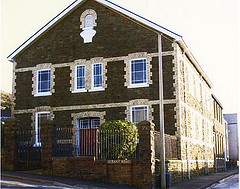This article is taken from Mrs Eileen Price’s brief history, ‘Tabernacl, Capel yr Annibynwyr, Pontycymer’. Copies of this can be obtained by ringing the editor on 01656 856091.

Tabernacle chapel, like many places of worship in the Garw, was built as a consequence of the huge influx of people coming into the Valley to work in the mines and their associated businesses.
In November 1881 Carmel Independent Chapel was opened in Pontyrhyl and attracted people from all the Valley as it was the only Independent chapel there. With Pontycymer expanding it was felt that Pontycymer should have its own place of worship, instead of people having to walk down to Pontyrhyl in all weathers, so a room was eventually found in the stable loft behind the Squirrel Hotel. Prayer meetings and Sunday schools were held there, with the attendees still retaining membership of Carmel.
With the expanding congregation a more suitable building was needed so ‘a magnificent and conveniently situated vestry was built in Meadow Street’ in 1884. A sister chapel, Nebo, was built in Blaengarw, and the new Tabernacle in Pontycymer separated from Carmel in Pontyrhyl, meaning that the Independent church now had bases in three areas.
After only a short time the vestry in Pontycymer was considered too small to hold the increasingly large congregations so in 1889 a new chapel was built next to the vestry. The English Congregational Church was built further along Meadow Street as its ‘twin’, but for the English speaking members.
Tabernacle chapel went from strength to strength. 1904-5 saw the opening of a new vestry and the installation of a new organ in the chapel, costing £2000, at the time of the great Revival. All members worked hard to pay off this enormous debt.
In 1909 it was registered for the conducting of weddings, and the following years saw a Band of Hope started for young children, a Youth Club, and a Debating Society; choral events such as oratorios, cantatas, and Gymanfa Ganus were common, packing the chapel, with many well-known artists taking part. Penny readings* many times filled the vestry to capacity, and Sunday School outings were very popular, when the whole chapel would march to the Railway station sporting Tabernacle ribbons, on the way to Barry or Porthcawl.
In 1914 at the outbreak of WW1, and later in 1939 with the start of WW2, knitting and sewing classes were held by the women to provide ‘Comforts’ for the troops. Memorial Tablets and a Roll of Honour naming those who lost their lives are still to be seen in the chapel.
As for the personnel involved in this flourishing institution, the list is endless. During its lifetime so far, Tabernacle has been truly blessed in its Ministers, its secretaries, its treasurers, its organists, its deacons and caretakers, its children, teachers and members. Their legacy endures, even though its heyday has passed.
Good morning
My grandfather built the Tabernacle Chapel organ in 1906. He began work on it on August 20th and packed it for dispatch on November 2nd. In the intervening weeks he lists the various parts that he is working on: pipes, passage board, drawstop rods, bourdon, case, pedals, etc. and lots of others – either abbreviations or parts I don’t recognise. I have his work book. He was employed by Martin and Coate, the Oxford organ builders for many years before joining the Oxford and Bucks Light Infantry in August 1914, dying in the Battle of Festubert the following May.
I would be happy to send the relevant pages of his work book if anyone is interested, and would be most grateful if you could send me a copy of Mrs Eileen Price’s brief history of the Chapel. Does the organ still exist? Would it be possible to have a photo of it?
I would make the pilgrimage to Pontycymer if it were possible, but have to be content with what I can glean online in the present circumstances.
Kind regards
Geoff Mawer
Hello, Geoff.
Thank you for getting in touch; Yes, we would like copies of your Father’s work book . The organ does still exist, and we have had held Heritage Exhibitions in Tabernacle featuring an organist playing a selection of Hymn & tunes. I will arrange to take some photographs of it and send them on to you along with a copy of Mrs. Price’s history. If you can send me your Email address by return I will organise this.
Regards Gerald.
Hello. I have a small piece of china that marked the centenary of the Tabernacle in 1989. It has come to me from my mother who was brought up in the valley. If you can supply an address I am happy to donate the commemorative piece. As an aside Mrs Eileen Price was my mother’s bridesmaid!
Hello Andrew
I’m a member of the GVHS and Eileen is my aunt. If I’m correct you would be Dr Clark’s son?
Unless another society member has contacted you, I’m happy to accept the china. My email address is webb_linda@yahoo.com
Kind regards
Linda Webb (Price)